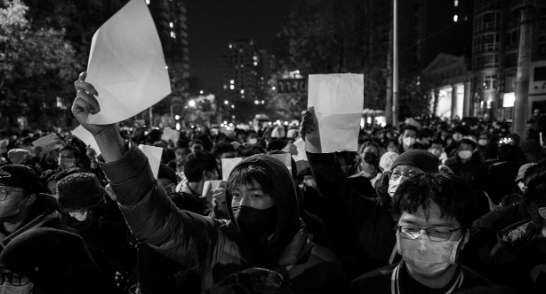How blank sheets of paper became a COVID protest symbol in China
At a China COVID protest, a mix of giddy elation and anxiety.

The people in China actively participating in one of many protests against a restrictive government.
December 13, 2022
Protesters in Chinese cities, angry over Beijing’s “zero COVID” policy, are using blank sheets of paper to get their message across.
As demonstrations flared over the past few days, participants have raised the white pages as a symbol — and protest — of government censorship. The sheets have also signaled a measure of unity among protesters, whose demonstrations now mark one of the greatest displays of public dissent in China to be seen for decades.
Protests are not actually rare in China, but authorities, who tightly control media and the internet, regularly go to great lengths to ensure that demonstrators in different regions are unable to link up to form a broader movement, according to analysts.
Mass anti-government protests with a unified message breaking out in different cities? That’s a “no-go zone,” said Matt Schrader, a China analyst with the Alliance for Securing Democracy at the German Marshall Fund.
However, he said, the blank paper protest – a tactic demonstrators also used in Hong Kong in 2020 – has layers of symbolism.
“It’s the idea that when no form of protest at all is acceptable to the state, then the only thing that you could possibly hold up that won’t offend anybody in power is a blank piece of paper,” Schrader said. “It’s the idea that any real form of protest online will mostly be censored.”
With this, he said, the blank piece of paper symbolizes the dissatisfaction “that everyone understands what they’re talking about, but they’re not actually able to name that thing that infuriates them.”
In highly censored environments such as China, “protest has to take on playful and inventive means in order to evade the censors,” Jemimah Steinfeld, editor-in-chief of the Index on Censorship, a London-based organization advocating for freedom of expression worldwide, said.
In China, even clever wordplay, puns, and hidden symbols have become more challenging to use.
After Chinese censors banned annual commemorations of the 1989 Tiananmen Square Massacre on June 4, internet users began to use “May 35.” Beijing banned that “date” too.
In 2013, “24th Anniversary” was banned; “25th Anniversary” in 2014; “26th Anniversary” in 2015, and so on. Beijing banned a pictogram that looks like a tank rolling over a man.
To get around censorship during the height of the #MeToo movement, Chinese internet users used the characters or emoji for “rice,” pronounced “mi” and “bunny,” pronounced “tu.” They had to do this so people could understand what they meant because of the censorship.
“But the blank sheet of paper is more likely to work,” Steinfeld said. “After all, how can you route out and punish someone who hasn’t said anything?”
Though the blank paper protest symbol is inconspicuous, even silent, some protesters are also making loud, explicit statements — some so extraordinarily strong that they’re rarely heard in China.
“Xi Jinping, step down!” and “Communist Party, step down!” a group of bold protesters chanted in Shanghai over the weekend. Others chanted for “Freedom!” or to “Unlock all of China!”
The protests, which spread over the weekend, reveal just how fed up people are after nearly three years of ongoing pandemic lockdowns, analysts said.
The final trigger was an apartment complex fire at Urumqi, Xinjiang, that killed 10 on Nov. 24th. People were outraged, saying pandemic restrictions on movement slowed and made ineffective the firefighters’ ability to rescue the victims.


